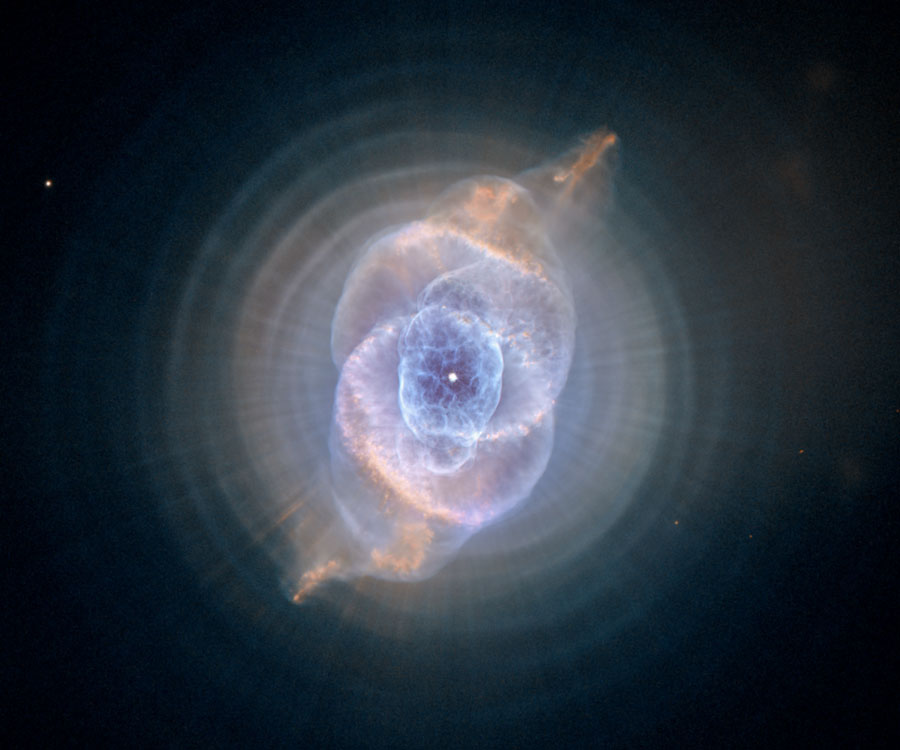One of my favorite types of object in the sky are planetary nebulae. These are typically compact, fantastically-shaped baubles caused the winds blown from stars as they die. One of the most complex and interesting is the famous Cat’s Eye nebula (NGC 6543, seen here). It’s easy to spot in a small telescope, and with large telescope an incredible amount of detail can be seen.
What most people don’t know is that there’s more to PNe (as we in the know call them) than the bright inner region. Many have giant outer halos, too! And the one surrounding the Cat’s Eye is fantastically complex and a treat for the eye and brain:
That stunning image is from the 2.5 meter Isaac Newton Telescope on the island of La Palma in the Canaries. The halo around the bright inner region is actually huge expanding shell of material centered on the nebula’s central star. And I do mean huge; that halo is nearly 6 light years across — 60 trillion km, or almost 40 trillion miles!
When the star first started to die, it expanded into a red giant, much larger and cooler than our Sun. The star blew a thick, slow wind of material from its surface, much denser and slower than the Sun’s solar wind. This material expanded and slammed into the material (gas and dust) between the stars. As it did so, the long delicate fingers and smaller, denser knots of material formed.
This is common in space when expanding material interacts with stationary material. It’s called
Rayleigh-Taylor instability, and can create incredibly beautiful and intricate-looking structures. In the Cat’s Eye halo, ultraviolet light from the central star causes the outer halo to glow like a fluorescent light. Different gases glow in different colors; here red is hydrogen, blue is sulfur, and green is oxygen.
Not that I’m knocking the inner region of the Cat’s Eye; it’s pretty cool too.
The small picture at the top of this post is from Hubble, and shows the core of the nebula. It formed after the outer halo; the star was a red giant when it blew the wind that formed the halo, but as it aged and lost mass it heated up, blowing a faster and thinner wind. This wind caught up with stuff blown out earlier, forming the amazing shapes in the inner part.
Deeper images of the core show even more things going on, too.
The picture here is also from Hubble, but shows different detail. Those concentric rings are shells of gas expelled as the star undergoes nuclear paroxysms in its core; oscillations in pressure squeeze and relax the core, making it fuse atomic nuclei faster or slower — think of it as a cosmic CPR. When this happens the star’s surface responds by blasting out material which expands and glows. In the Cat’s Eye these events happen every 1500 years or so, making the star look like it’s sitting in the center of a series of
Russian matryoshka nesting dolls.
It’s common in other planetary nebulae as well.
Many other nebulae have such outer haloes; for my Master’s degree I studied NGC 6826 which has an ethereal,
almost perfectly circular halo, seen here (the image is a negative which makes it easier to see faint detail; click it to get a bigger version). Unlike the Cat’s Eye, NGC 6826′s halo has a rim around it, probably due to matter piling up as the expanding halo snowplows the surrounding material. You can see dips and kinks in the outer rim, where the halo has rammed slightly denser material. When compressed that material glows more brightly, which you can see in the upper left part of the halo.
I still remember those long nights at the University of Virginia’s Fan Mountain observatory, using the brand new digital camera (in 1989!), laboriously changing the filters and taking one half-hour exposure after another of NGC 6826. Initially I was going after the inner region to examine its structure, but when my advisor and I saw that halo (which at the time wasn’t well-known) we changed direction in mid-course and I worked on the outer material instead. That was fun, and resulted in a
short paper in the Astronomical Journal.
But it also started a life-long love of these beautiful objects. Every time I see a new one, or an old one in a new way, I get a little thrill. I feel a connection to them because of the years I spent studying them, and because of the deeper knowledge I have of them. They can be stunningly beautiful, and for me that beauty is amplified by understanding.
 The Cat's Eye Nebula from Hubble
The Cat's Eye Nebula from Hubble





